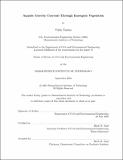Aquatic gravity currents through emergent vegetation
Author(s)
Tanino, Yukie, 1980-
DownloadFull printable version (4.976Mb)
Other Contributors
Massachusetts Institute of Technology. Dept. of Civil and Environmental Engineering.
Advisor
Heidi M. Nepf.
Terms of use
Metadata
Show full item recordAbstract
Differential heating and cooling can generate density-driven, lateral exchange flows in aquatic systems. Despite the ubiquity of wetlands and other types of aquatic canopies, few studies have examined the hydrodynamic effects of aquatic vegetation on these currents. This study investigates the dynamics of lock-exchange flows, a particular class of density currents, propagating through rigid emergent vegetation. First, previous mathematical formulation is extended to develop theoretical models of vegetated lock-exchange flows. The regime in which stem drag is inversely proportional to velocity is considered as a special case. Lock-exchange flows were generated in a laboratory flume with rigid cylindrical dowels as model vegetation. Experimental observations were consistent with the theory. Under high stem drag or low stem Reynolds number conditions, the interface deviated from the well-documented block profile associated with unobstructed lock-exchange flows and approached a linear profile. Criteria are developed to categorize all flow conditions as inertial or non-inertial and the interface profile as linear, transitional, or non-linear, respectively, based on (a) the evolution of the velocity of the leading edge of the undercurrent and (b) the interface shape. Finally, the present model is enhanced to account for wind forcing and bed friction to better describe conditions found in nature. The theory highlights the sensitivity of currents to wind forcing.
Description
Thesis (S.M.)--Massachusetts Institute of Technology, Dept. of Civil and Environmental Engineering, 2004. This electronic version was submitted by the student author. The certified thesis is available in the Institute Archives and Special Collections. Includes bibliographical references (leaves 109-112).
Date issued
2004Department
Massachusetts Institute of Technology. Department of Civil and Environmental EngineeringPublisher
Massachusetts Institute of Technology
Keywords
Civil and Environmental Engineering.